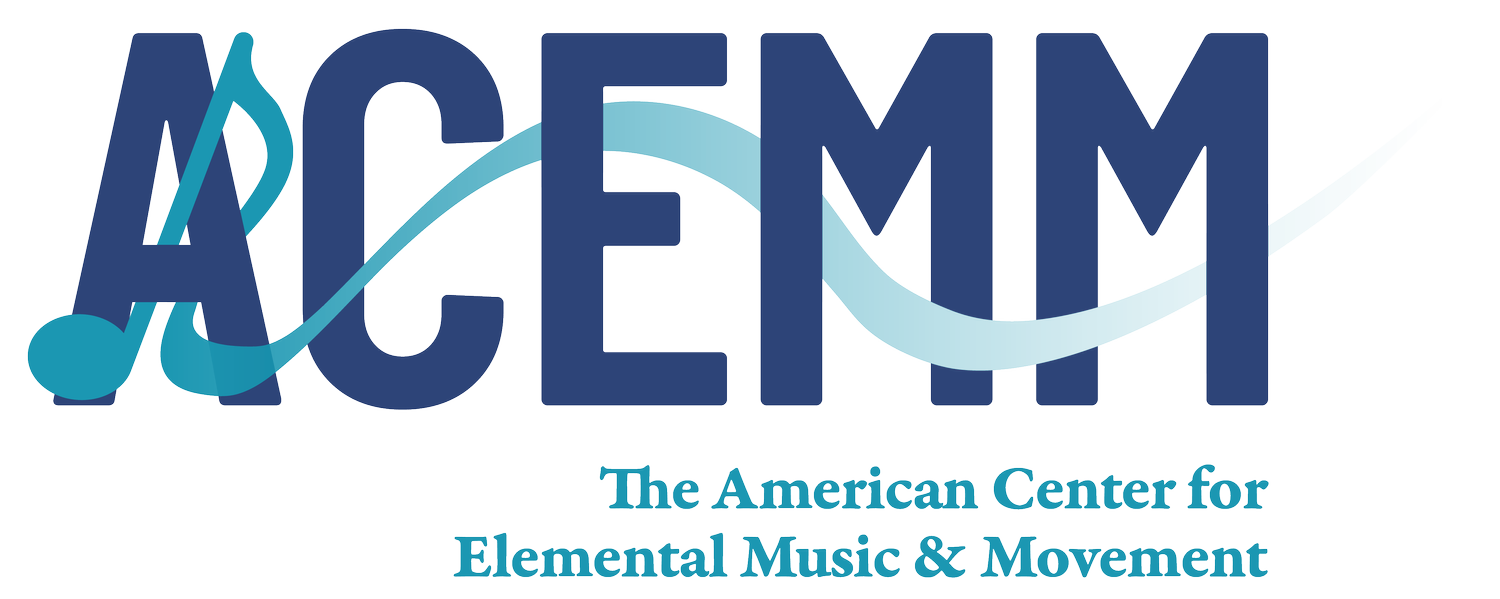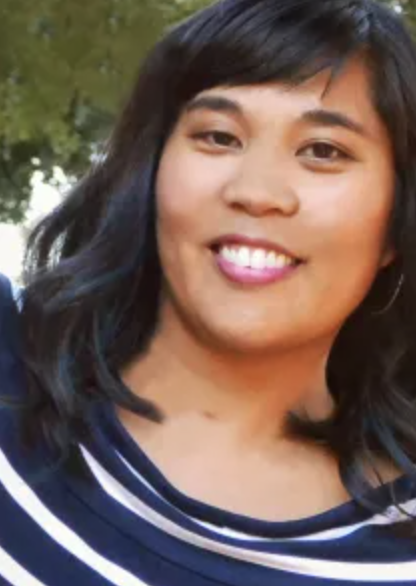The Elemental Approach – Resources and Ideas: “Why are We Doing This?”
An Elemental Approach to Learning with Older Students
by Lorelei Batisla-ong,
ACEMM Spotlight Recipient - Winter, 2015
“What is a young adult’s natural inclination toward learning, and how is that different from that of a child…?”
First Encounters – First Impressions
It has been quite a while since I’ve stood in front of students, asked them to stand up and move to the center of the floor, and was met with blank stares. Blank, incredulous stares. I may have heard a cricket’s lament off in the far distance, too.
Perhaps their hesitation stemmed from the fear that they were on the receiving end of a joke, or being unwillingly included as subjects in a study on human behavior. But this is exactly what happened my first day of teaching an undergraduate class of non-music majors. I articulated a directive, something that would not be out of the ordinary in a normal music classroom, and it was as if I had asked them to re-enact their most embarrassing memory. Nervous laughter and searching side to side glances seemed to say, “Is she serious?”
Incorporating the medium of singing brought a new level of reluctance, measured with plain refusals to participate, and answered by me, the seasoned teacher, in the most desperate of ways – threats to their grades. It is not something I am proud of.
I believed my teaching had evolved beyond this, but much like those students whose first reaction was to revert to shutting down, my survival instinct kicked in and I resorted directly to behaviorism and rewards/consequences. I heard the threat leave my lips and instantly my gut wrenched.
“Both my students and I were so surprised to be asked to do something we hadn’t done in years”
Years of dutifully following directions and years of teacher training went by the wayside because both my students and I were so surprised to be asked to do something we hadn’t done in years. For me, that resulted in a sweaty, stammering lesson delivery. For my students, that showed in nervous laughter, slow movement to action, and refusal to participate.
As an avid participant in professional development opportunities over the course of my 15 years in music education, beginning a workshop with movement and activity is second nature. We don’t talk about what we’re going to do first, we do what we’re going to do first. My body craves this like it craves a cup of coffee first thing in the morning. So, you can imagine my surprise when my opening activity bombed spectacularly.
When teachers facilitate music in an elemental way, we frame it within a child’s natural inclination for play. Child’s play. It is natural for children to participate when the context is within a game or activity. We strive to create an environment that is safe, and encourage experimentation regardless of perceived success. When applying this approach to older students, one discovers a gap regarding the evolution of their learning process.
“I assumed that what I was teaching and how I was teaching it would not be lost in translation”
What is a young adult’s natural inclination toward learning, and how is it different from that of a child’s point of view? Teaching and learning in a traditional classroom environment is different than that in the general music classroom. The requirement to meet mandates can pressure some to abandon the hands-on approach for the more time-tested lecture format. It is the novelty of operating within an experiential environment and my failure to recognize this, that interrupted that first lesson. I assumed that what I was teaching and how I was teaching it, would not be lost in translation. My students and I were speaking different dialects of the same language. We both spoke School, but not in the same way.
Along with forgetting the simple joy of the experience, the act of denying one’s own vulnerability in the experience can be a contributing social aspect that hinders learning among older students. What has life taught them between leaving fifth grade, eager and unconcerned with criticism, and then meeting me again as a freshman in college, hesitant to take a chance for fear of the implications regarding social hierarchy? Educators observe this as primary-aged children become older elementary students. How often do we confide in each other, “Something is happening – they are worried about not being considered cool.”
“The first day as a teacher of young adults whose academic focus was not music challenged my flexibility and adaptability….”
Can the need for acceptance shape our willingness to take a chance? Is that what I observed that first day of class? As we grow, we put away childish things. Why? How can we combat this continued progression? Should we? The first day as a teacher of young adults whose academic focus was not music but perhaps engineering, physics, or Pre-Med challenged my flexibility and adaptability, and caused me to ask these questions.
There is no easy, immediate remedy to successful elemental teaching when you are battling years of learned behavior on the part of the students. I tend to communicate clearly and model high expectations of musicality and participation. I do not shy away from dispensing negative feedback, and dole it out with discretion and without emotion, but always with the intent of changing a behavior. As Duke (2005) states, we learn only when we register a mistake and have the tools to strategize a solution. This is one of our roles as a teacher – calling attention to something that is not right and arming our students with the tools to search out another solution. Young adults, and I will even argue, elementary students, are capable of this skill. We should not shy away from feedback for fear of breaking them, or worse them not liking us, but we should expect them to rise to our expectations and not be surprised when they do, as they so often do when given the chance.
What I took for granted in that first movement activity were the steps necessary to facilitate that mode of learning. Moving, singing, and the whole-body experience needed to be normalized first. I now find myself starting each semester by establishing the culture of our classroom. Moving, singing, and playing become central to both learning and creating an environment where engaging in these media becomes acceptable. All of this must be made apparent before any music content can be learned.
This is most effectively established by doing these activities at every meeting, and positively reinforcing appropriate participation. We sing. We move. We break into small group discussions. We share out. We continue to do these things until it is normalized. I constantly assess each class’s natural tendencies and provide activities that bridge the gap from what they know of music to what I want to them to learn of music. There are moments when singing is uncomfortable. It will be that way until it is apparent and normal that we sing. Presenting lessons that encapsulate singing within a desirable activity has softened my delivery. Incorporating group guitar and group ukulele, interspersed with familiar songs has encouraged many to literally find their voice. This is a compromise, but one I am willing to make. I have foregone a strictly authentic folk song repertoire in order to establish buy-in to the activity.
This does not mean that we do not sing folk songs, but it means I find time to sing those songs they know from their life. Singling out activities that might challenge both of us creates a commonality between us. We are building . We meet in the middle as opposed to expecting the other to swim across the river and complain when the other party won’t do it.
“There is no greater motivation than to realize the value of what we do and how it applies to the world we live in…”
Why are we doing this? As I work with older students, relating what they learn to what they experience in daily life has become more urgent, and is a tool I use to justify what they are doing and how they are doing it. There is no greater motivation than to realize the value of what we do, and how it applies to the world we live in, especially for those who are on the precipice of independent adulthood.
A new aspect of teaching older students is explicitly verbalizing this transfer to their lives and calling attention to the actual learning process while they are in the thick of it. I wouldn’t necessarily do that for all my elementary students carte blanche, but I do this for my undergrads. Encouraging depth of study is supported by reflection, and I encourage this by always going back to the question – “Why are we doing this?”
In my specific circumstance, I am re-establishing the tools necessary to facilitate elemental learning. I work in tandem with my students to create an environment that encourages buy-in to this way of thinking, and I draw attention to how MUS 303C Classroom Instruments applies to their academic life beyond attaining the Visual and Performing Arts Component of their undergraduate degree. How does this differ in any way from a general music teacher in an elementary school?
What I have discovered so far in the switch from the elemental public school general music classroom to establishing an elemental public university undergraduate course, is that not much is new or unique to either age-level. It is an educator’s struggle at all levels.
I have also discovered that 20-year-olds are just as excited about the cabasa, whip, and ratchet as any elementary student. For that brief, beautiful moment they are all seven-year-olds again and that is what makes me realize we are going to be okay on this journey together.
May you be the guiding light to child-like excitement in your teaching, so that when they come to me, they can be reminded to never lose it.
Lorelei Batislaong is a 14-year veteran of the elementary music classroom.
Lorelei was selected as ACEMM’s Spotlight Award Winner in December of 2015.
She has served on the AOSA National Board of Trustees as Region III Representative, and is the State Director of the Texas Music Educators Conference, the state affiliate of NAfME. Along with presenting sessions and clinics at the state and local level, she is currently working on a Ph.D. in Music and Human Learning at the University of Texas and is an Assistant Instructor teaching an undergraduate music course to non-music majors. In her spare time, she gigs around Austin playing the bass ukulele in an all-girl folk band.




